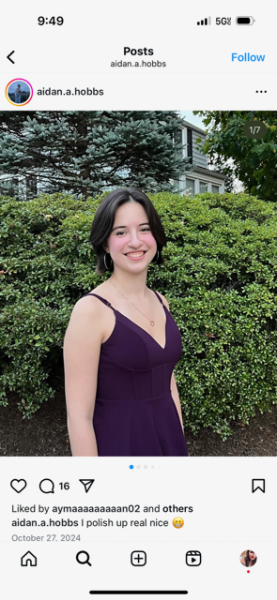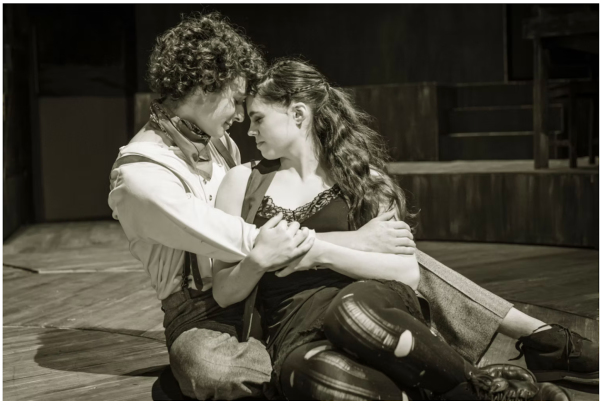D.C. street art: Explained by a political graphic artist
[slideshow_deploy id=’8751′]
Brightly colored photographs of posters and graffiti flood the screen as Democratic political graphic artist Kate Connolly designs a page in her book dedicated to the documentation of street art in Washington, D.C. Unknown to some, the nation’s capital holds a plethora of street art waiting to be admired, and for Arlingtonians just involves a trip across the river.
Aside from being author of her two books “DC H@te$ Trump” and “DC H@te$ COVID,” Connolly has also worked for the Obama, Biden and Hillary Clinton campaigns. With a major in politics and fine arts at Washington and Lee University, the now-designer of political mail was not always sure what her degree would mean for her in the future.
“My joke in college was, ‘Well, what am I going to do with a politics and fine art degree, design political mail?’” Connolly said. “Then I realized that that actually is a job.”
Connolly normally works for local candidates, but has done work for presidential candidates in the past as well. Her clients write the words, but after that it is up to her to create an effective piece of mail.
“I add the pictures, I design the thoughts and the layouts,” Connolly said. “It’s like designing a newspaper, but it’s an eight by 11 and a half [inch] piece of mail that people look at for eight seconds,” Connolly said. “It makes a huge difference if you send it out correctly, so that’s what I do.”
Aside from designing political mail for a living, Connolly has other creative projects to keep her inspired as well as to give her a break from politics. This includes taking headshots, cartooning, creating portraits and doing wedding photography.
“A lot of times you don’t want to think about politics,” Connolly said. “On the other hand, sometimes you want to do something, like in my real job I think I do something positive. And with the street art, I feel like I got to do something positive and do a good thing as well. Sometimes you need a break, and sometimes you need to dive into it.”
Connolly said her documentation of street art started with her passion for running.
“I’ve done two marathons, and I run pretty much everyday,” Connolly said. “When you’re running, it’s really nice to keep your eye out for things. It makes it a little more fun to have a scavenger hunt while you’re running. The scavenger hunt helps my runs, and makes them more engaging.”
Connolly started out taking pictures of D.C. scenery, however, once Clinton lost the 2016 election and political street art started popping up, she became inspired by something some may not have expected.
“I started documenting when I saw ‘Donald Trump is a pig’ written in the snow,” Connolly said. “That was temporary, and probably would have melted by the next day, but I just took a picture. After that, I started noticing all of the Trump related street art, but then I noticed that there was also Brett Kavanaugh, Betsy DeVos, and Mike Pence , and also dedicated issues like coronavirus and Black Lives Matter, which I put in my second book.”
Connolly said the amount of street art she finds varies, but that it tends to go up when Trump’s approval rating goes down.
“The amount of graffiti was very high the first two years of his presidency, and then it went down a little bit…but then it went way up, starting around the time George Floyd’s death surfaced and the Black Lives Matter protests began happening,” Connolly said. “It also went way up with COVID as well.”
As for graffiti in support of Trump, a contrast to the usually prominent anti-Trump street art she documents, Connolly said there is almost none.
“In the past four years, I have only seen pro-Trump graffiti twice,” Connolly said. “There was one near George Washington University where someone said ‘f*** Trump,’ and then someone was like ‘No, I love Trump!’ in response. Also, in Dupont Circle, someone wrote ‘MAGA Trump 2020’ in one of the four crosswalks, and it’s not very prominent, but it’s still there.”
Because of the presidential election, some might assume that there is Biden-related graffiti as well. However, this is not the case.
“In my opinion, this next election for liberals is more anti-Trump than it is pro-Biden,” Connolly said. “The people that are voting for Biden are likely voting more against Trump than anything else, so no one is going out there and graffitiing about Biden specifically.”
Connolly has also seen a few examples of graffiti that concern other Democrats and Republicans besides presidential candidates.
“In the first two years after the election, I would see graffiti that said things like ‘Thank you Obama,’ and I saw AOC tags as well,” Connolly said. “I also saw a tag that said ‘Go Oprah’ when Oprah might have been running for something. There’s also lots of Melania, Ivanka, and other Trump administration ones.”
In the wake of the death of Supreme Court Justice Ruth Bader Ginsburg, before her funeral many ventured into D.C. to mourn her death by bringing flowers, signs, and more, thus creating street art, but most of it has now been removed.
“There was a sign as well before she passed that said ‘RBG works less than five miles away from here, if you won’t wear a mask to protect your friends and family do it for RBG,’ but I haven’t seen much art necessarily honoring her after the funeral,” Connolly said. “Maybe people are more motivated by anger than respect.”
Connolly has seen many tags and other forms of street art, but said the ones that she likes the best include conversation, and might even make her laugh.
“About a block away from where I live, someone wrote ‘f*** Trump’, and then a completely different person said ‘yeah, and Pence,’” Connolly said. “There were also these stickers in DC, these anti-Trump yellow stickers that often said the same thing, but some of them were really funny, like ‘Trump prefers garbanzo beans over chickpeas.’”
After realizing that she needed to do something with all of the photos that she had collected, Connolly made the decision to use the photos to create a book about one or two years into Trump’s presidency. Connolly self published ‘DC H@te$ Trump’ by using Blurb.com in the beginning of June this year.
“In such an online world, it’s so refreshing to have something in print that you can hold, that you know is not going to be deleted off the web,” Connolly said. “I’m a graphic designer, so I used my graphic design software, got the books together, and found a theme I liked. It was kind of therapeutic just because politics have not been great since 2016, at least on my side of the aisle, so I did it sort of as therapy and for fun.”
When determining an endpoint for her first book, which focused on Trump, Connolly said she found it to be a challenge at first.
“The Trump book kept going and going because I kept coming across more street art and adding more pages, so COVID kind of drew a line in the sand for me, and I decided to print it then,” Connolly said. “I told my Facebook friends that if they bought my book, I’d donate the proceeds to a good cause.”
She originally wanted to donate the profits of her books to Black Lives Matter or a direct social justice cause, but ended up donating the money to where she felt it would be best used.
“My husband and I donated what I did make, and added in our own money, and donated quite a lot to the Biden campaign and a few other Senate campaigns that we believed in, [such as] Mark Kelley, a former astronaut in Arizona and Jaime Harrison in South Carolina, who has a chance to beat long term incumbent and hypocrite Lindsey Graham,” Connolly said. “My husband does polling and research for a living, so he and I know the value of those dollars in tight campaigns. Also, aside from Biden versus Trump, if we don’t flip the Senate then it’ll still be hard to pass certain laws later.”
As for future book projects, Connolly does not have any in the cards yet.
“I really hope Biden wins so that there is not so much anger that produces graffiti,” Connolly said. “God forbid Biden doesn’t win, I’m sure I’ll still be there to therapeutically document it.”
Despite writing two books on street art, Connolly is not all for it.
“The interesting thing is, most street art is illegal, unless the murals were commissioned,” Connolly said. “A lot of times, it gets washed off. It’s good trouble, like what John Lewis said. I’m on the side of it being good trouble, but at the same time it’s still trouble.”
Connolly said that there are areas in which most of the street art D.C. has to offer can be found, and art can also be found on temporary infrastructure as well, such as electric boxes and barriers. This is due to the fact that most people are likely to graffiti on something that won’t be there forever, but will be in the moment.
“Anything close to the White House or the political buildings are hot spots, and the further you get away from that the less you’ll see,” Connolly said. “With the Black Lives Matter protests, they covered everything down nearby the White House.”
According to Connolly, the best times to go out and look for or visit the street art in the district are after major events, such as the Women’s March and the George Floyd protests when signs are often left out.
“During historical [moments], or what feels historical at least, I’d say with safety in mind, I would come and see what happened,” Connolly said. “On a normal day, I would say there isn’t as much to go out of your way for and see.”
For those interested in politics, Connolly also shared some ways to get involved, even if one cannot vote.
“Donate what you are talented or good at for a cause – like me using my graphic design or art skills, or writing to further a cause,” Connolly said. “Volunteering and giving your time to a cause is [also] great when you can’t give money. If you don’t have time or talent, then just give money.”
Overall, Connolly said she felt more in touch with her community through her journey of documenting street art and has taken away some valuable knowledge.
“People pay attention, and some people can be really smart and clever at times,” Connolly said. “People care and will express their views, and it’s not just expressing your views on social media, or something temporary, it’s like they’re putting their stamp in the real world.”









